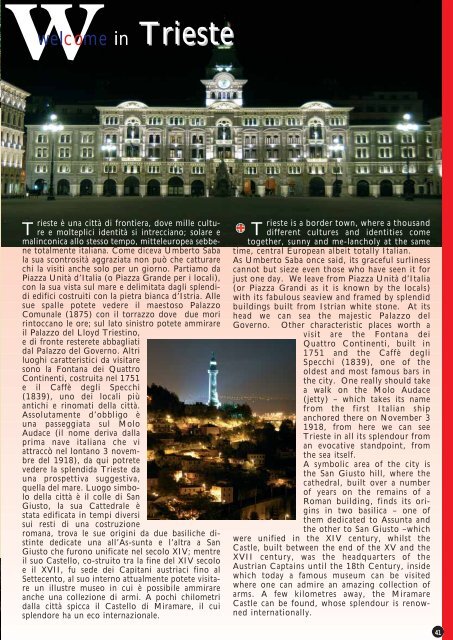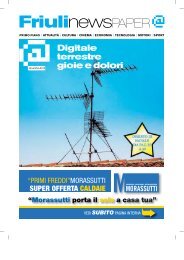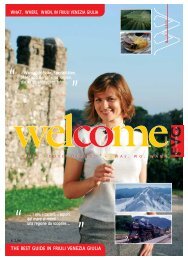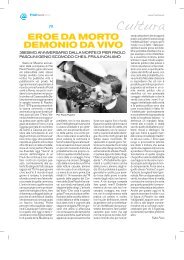You also want an ePaper? Increase the reach of your titles
YUMPU automatically turns print PDFs into web optimized ePapers that Google loves.
<strong>welcome</strong> in Trieste<br />
rieste è una c<strong>it</strong>tà di frontiera, dove mille cultu-<br />
T re e molteplici ident<strong>it</strong>à si intrecciano; solare e<br />
malinconica allo stesso tempo, m<strong>it</strong>teleuropea sebbene<br />
totalmente <strong>it</strong>aliana. Come diceva Umberto Saba<br />
la sua scontros<strong>it</strong>à aggraziata non può che catturare<br />
chi la vis<strong>it</strong>i anche solo per un giorno. Partiamo da<br />
Piazza Un<strong>it</strong>à d’Italia (o Piazza Grande per i locali),<br />
con la sua vista sul mare e delim<strong>it</strong>ata dagli splendidi<br />
edifici costru<strong>it</strong>i con la pietra bianca d’Istria. Alle<br />
sue spalle potete vedere il maestoso Palazzo<br />
Comunale (1875) con il torrazzo dove due mori<br />
rintoccano le ore; sul lato sinistro potete ammirare<br />
il Palazzo del Lloyd Triestino,<br />
e di fronte resterete abbagliati<br />
dal Palazzo del Governo. Altri<br />
luoghi caratteristici da vis<strong>it</strong>are<br />
sono la Fontana dei Quattro<br />
Continenti, costru<strong>it</strong>a nel 1751<br />
e il Caffè degli Specchi<br />
(1839), uno dei locali più<br />
antichi e rinomati della c<strong>it</strong>tà.<br />
Assolutamente d’obbligo è<br />
una passeggiata sul Molo<br />
Audace (il nome deriva dalla<br />
prima nave <strong>it</strong>aliana che vi<br />
attraccò nel lontano 3 novembre<br />
del 1918), da qui potrete<br />
vedere la splendida Trieste da<br />
una prospettiva suggestiva,<br />
quella del mare. Luogo simbolo<br />
della c<strong>it</strong>tà è il colle di San<br />
Giusto, la sua Cattedrale è<br />
stata edificata in tempi diversi<br />
sui resti di una costruzione<br />
romana, trova le sue origini da due basiliche distinte<br />
dedicate una all’As-sunta e l’altra a San<br />
Giusto che furono unificate nel secolo XIV; mentre<br />
il suo Castello, co-stru<strong>it</strong>o tra la fine del XIV secolo<br />
e il XVII, fu sede dei Cap<strong>it</strong>ani austriaci fino al<br />
Settecento, al suo interno attualmente potete vis<strong>it</strong>are<br />
un illustre museo in cui è possibile ammirare<br />
anche una collezione di armi. A pochi chilometri<br />
dalla c<strong>it</strong>tà spicca il Castello di Miramare, il cui<br />
splendore ha un eco internazionale.<br />
T<br />
rieste is a border town, where a thousand<br />
different cultures and ident<strong>it</strong>ies come<br />
together, sunny and me-lancholy at the same<br />
time, central European albe<strong>it</strong> totally Italian.<br />
As Umberto Saba once said, <strong>it</strong>s graceful surliness<br />
cannot but sieze even those who have seen <strong>it</strong> for<br />
just one day. We leave from Piazza Un<strong>it</strong>à d’Italia<br />
(or Piazza Grandi as <strong>it</strong> is known by the locals)<br />
w<strong>it</strong>h <strong>it</strong>s fabulous seaview and framed by splendid<br />
buildings built from Istrian wh<strong>it</strong>e stone. At <strong>it</strong>s<br />
head we can sea the majestic Palazzo del<br />
Governo. Other characteristic places worth a<br />
vis<strong>it</strong> are the Fontana dei<br />
Quattro Continenti, built in<br />
1751 and the Caffè degli<br />
Specchi (1839), one of the<br />
oldest and most famous bars in<br />
the c<strong>it</strong>y. One really should take<br />
a walk on the Molo Audace<br />
(jetty) – which takes <strong>it</strong>s name<br />
from the first Italian ship<br />
anchored there on November 3<br />
1918, from here we can see<br />
Trieste in all <strong>it</strong>s splendour from<br />
an evocative standpoint, from<br />
the sea <strong>it</strong>self.<br />
A symbolic area of the c<strong>it</strong>y is<br />
the San Giusto hill, where the<br />
cathedral, built over a number<br />
of years on the remains of a<br />
Roman building, finds <strong>it</strong>s origins<br />
in two basilica – one of<br />
them dedicated to Assunta and<br />
the other to San Giusto –which<br />
were unified in the XIV century, whilst the<br />
Castle, built between the end of the XV and the<br />
XVII century, was the headquarters of the<br />
Austrian Captains until the 18th Century, inside<br />
which today a famous museum can be vis<strong>it</strong>ed<br />
where one can admire an amazing collection of<br />
arms. A few kilometres away, the Miramare<br />
Castle can be found, whose splendour is renowned<br />
internationally.<br />
41













